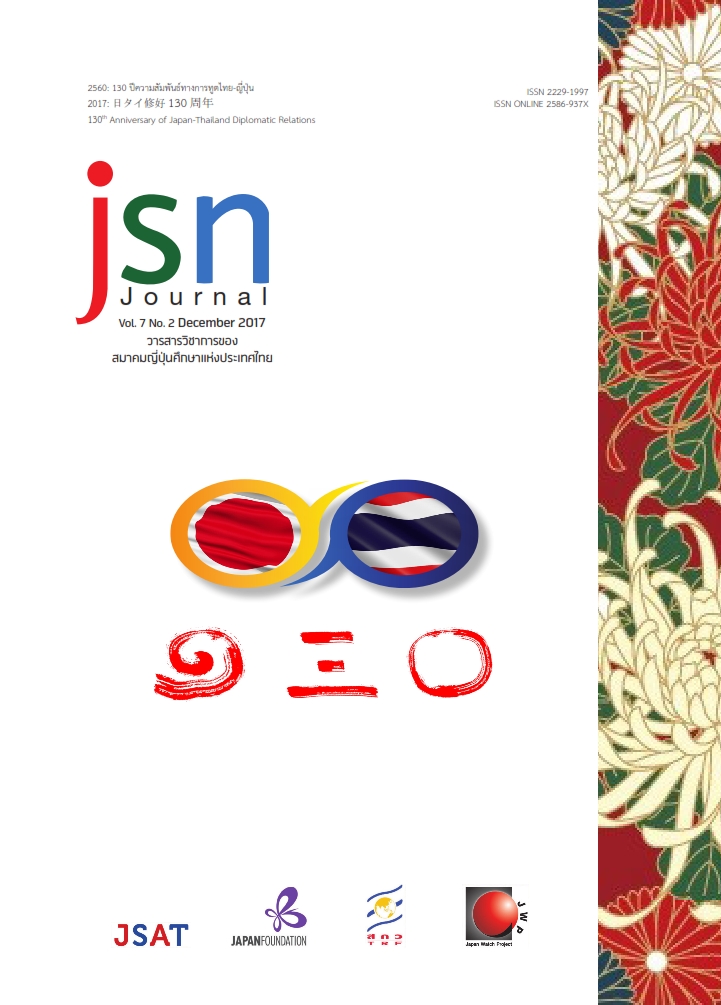The Taste of Unity: Nostalgia and Innovation in Tokyo’s Tsukishima Monja
Main Article Content
Abstract
This paper examines monja, a savory Japanese pancake, which is a popular “B-class gourmet” cuisine of Tokyo’s Tsukishima district. Drawing from the literature on monja and an interview with Kazuhide Kataoka of the Tsukishima Monja Promotion Society Cooperative Association, the study focuses on the innovation of monja, its usage, and the value of its taste in the community. It found that the communal history and consciousness of a “strangers’ community” has enabled the flexible acceptance of tastes from both inside and outside the community, integrating them as the unique taste of Tsukishima. The Taste of Unity: Nostalgia and Innovation in Tokyo’s Tsukishima.
Article Details
ข้อความและข้อคิดเห็นต่างๆ ในบทความเป็นของผู้เขียนบทความนั้นๆ ไม่ใช่ความเห็นของกองบรรณาธิการหรือของวารสาร jsn Journal
References
Brau, L. (2010). Oishinbo’s adventures in eating: Food, communication, and culture in Japanese comics. In T. Johnson-Woods (Ed.), Manga: An anthology of global and cultural perspectives. New York, NY: Continuum Books, pp. 109-127.
Bungeishunjū. (Ed.). (1986). Sūpāgaido Tōkyō bīkyū gurume [Super guidebook: Tokyo’s B-class gourmet]. Tokyo: Bungeishunjū. (in Japanese).
Cwiertka, K. J. (2006). Modern Japanese cuisine: Food, power and national identity. London, UK: Reaktion Books.
Hatanaka, M. (2016). Gurumeka, mukokusekika, soshite herushīka [Gourmet, statelessness and healthy booms]. In M. Saito and R. Narita (Ed.), 1980 nendai [The 1980s]. Tokyo: Kawadeshoboshinsha, pp. 71-76. (in Japanese).
Hayami, K. (2011). Bīkyū gurume no seiki jankufūdo to surōfūdo no dainamikusu [The B-class gourmet century: Dynamics of junk food and slow food]. Yuriika shi to hihyō: Tokushū bīkyū gurume-rāmen, karē, tonkatsu, yakisoba ... nihonjin ni totte shokutowa nanika [Eureka poetry and critiques: Special issue, B-class gourmet cuisine ramen, curry, tonkatsu, yakisobaHow do Japanese people see food?], pp. 88-95. (in Japanese).
Iikubo, T. (2011). Satomi Shinzō no oishii Tōkyō ron [The delicious Tokyo of Shinzō Satomi]. Yuriika shi to hihyō: Tokushū bīkyū gurume-rāmen, karē, tonkatsu, yakisoba ... nihonjin ni totte shokutowa nanika [Eureka poetry and critiques: Special issue, B-class gourmet cuisine ramen, curry, tonkatsu, yakisoba How do Japanese people see food], pp. 81-83. (in Japanese).
Koboreya. (2017). Koboreya hōmupēji. Retrieved from http://tsukishima-monja-koboreya.com/ (Accessed February 16, 2017). (in Japanese).
Koyama, K. (2015, February 25). Hōsōsakka Koyama Kundō san: Kachi wa nichijō niari (3) [Mr. Koyama Kundō, Broadcast Writer: Values exist in daily life]. Nihon Keizai Shimbun (evening edition). (in Japanese).
Mintz, S. W. (1996). Tasting food, tasting freedom: Excursions into eating, culture, and the past. Boston, Massachusetts: Beacon Press.
_____ (2006). Food at moderate speeds. In R. Wilk (Ed.), Fast food/slow food: The cultural economy of the global food system. Lanham, MD: Altamira Press, pp. 3–12.
Takeda, N. (2009). Monja-yaki no shakaishi: Tōkyō Tsukishima no kingendai no henyō [Sociology of monja-yaki: Transformation of Tokyo’s Tsukishima in the modern and contemporary periods]. Tokyo: Aoyumisha. (in Japanese).
Tokyo Metropolitan Government. (2016). Heisei 27 nendo kunibetsu gaikokujinryokōsha kōdōtokusei chōsa hōkokusho [Report on the 2016 survey of overseas tourists’ behaviors by country]. Tokyo: Author. (in Japanese).
Tsukishima Monja Promotion Society Cooperative Association (TMPSCA) (2016). Tsukishima shūhen monjayasan no goannai [Guide to monja restaurants around Tsukishima]. Tokyo: Author. (in Japanese).
Yomota, I. (2007). Tsukishima monogatari futatabi [Tsukishima stories once more]. Tokyo: Kōsakusha. (in Japanese).


